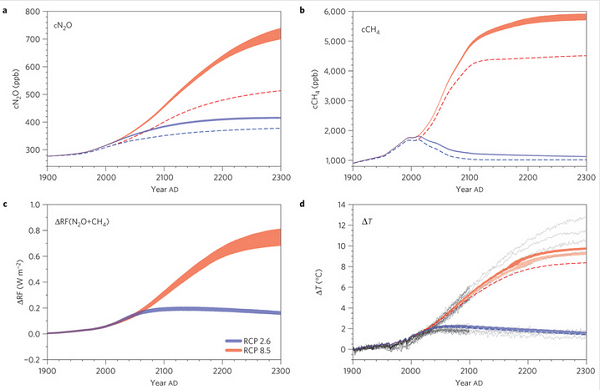
Fig 4: a,b, Simulated cN2O (a) and cCH4 (b) in the fully coupled (ranges) and the control (dashed lines) simulations for RCP2.6 (blue) and RCP8.5 (red). Results are from online simulations. Higher concentrations in the fully coupled simulations are due to amplified emissions in response to changes in both climate and cCO2. c, Additional radiative forcing due the higher cN2O and cCH4 in the fully coupled simulation compared with the control simulation. Changes in cCH4concentrations affect stratospheric cH2O and cO3. Resulting radiative forcings are included in RF(CH4). d, Global mean temperature change in the control simulation (dashed line), the fully coupled simulation (upper range), and the fully coupled simulation without changes in eN2O and eCH4 affecting climate (lower, pale-coloured range) for RCP2.6 (blue) and RCP8.5 (red). Grey lines represent ?T as simulated by the ensemble of CMIP5 models applied.
Multiple greenhouse-gas feedbacks from the land biosphere under future climate change scenarios
Atmospheric concentrations of the three important greenhouse gases (GHGs) CO2, CH4 and N2O are mediated by processes in the terrestrial biosphere that are sensitive to climate and CO2. This leads to feedbacks between climate and land and has contributed to the sharp rise in atmospheric GHG concentrations since pre-industrial times. Here, we apply a process-based model to reproduce the historical atmospheric N2O and CH4 budgets within their uncertainties and apply future scenarios for climate, land-use change and reactive nitrogen (Nr) inputs to investigate future GHG emissions and their feedbacks with climate in a consistent and comprehensive framework1. Results suggest that in a business-as-usual scenario, terrestrial N2O and CH4 emissions increase by 80 and 45%, respectively, and the land becomes a net source of C by AD 2100. N2O and CH4 feedbacks imply an additional warming of 0.4–0.5?°C by AD 2300; on top of 0.8–1.0?°C caused by terrestrial carbon cycle and Albedo feedbacks. The land biosphere represents an increasingly positive feedback to anthropogenic climate change and amplifies equilibrium climate sensitivity by 22–27%. Strong mitigation limits the increase of terrestrial GHG emissions and prevents the land biosphere from acting as an increasingly strong amplifier to anthropogenic climate change.
Multiple greenhouse-gas feedbacks from the land biosphere under future climate change scenarios
Benjamin D. Stocker, Raphael Roth, Fortunat Joos, Renato Spahni, Marco Steinacher, Soenke Zaehle, Lex Bouwman, Xu-Ri & Iain Colin Prentice
Nature Climate Change (2013) doi:10.1038/nclimate1864
Received 30 July 2012 Accepted 01 March 2013 Published online 14 April 2013
